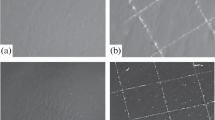Conclusions
-
1.
Through modification of epoxy resins by means of liquid rubbers (NVB-2 thiokol, SKN-10-1A carboxylate, etc.), use of thermoplastic and elastomer powder fillers, and thermal jet spreading of powdered polymers on epoxy primings, it is possible to increase significantly the cavitation resistance of epoxy coatings.
-
2.
High cavitation resistance, close to that of 1Kh18N9T chrome-nickel steel, is obtained from coatings made from highly resilient materials (chlorosulfated polyethylene, divinylstyrene thermoelastoplastic, chloropene, polyurethane, soft rubber).
-
3.
Resilient coatings, cushion and absorb the force of the cavitation impacts and reduce the effect of the impulses which tend to remove the superficial material. The protective capacity of resilient coatings against cavitation wear increases as the coatings are made thicker.
-
4.
For practical utilization of resilient, polymer coatings for protection of hydraulic machines against wear, it is necessary to follow carefully the techniques for preparation of the surface, preparation of the composition, and application of the coating and for establishment of the composition of combined coatings, to take into account the operating characteristics of the particular machine, and, primarily, the intensity of the cavitation.
Similar content being viewed by others
Literature Cited
V. Ya. Karelin, Wear of Blade Hydraulic Machines under Cavitation and Sediment Transport [in Russian], Mashinostroenie, Moscow (1970).
I. M. Kats and R. E. Yazev, “Anticavitation epoxy and combined polymer coatings for repair and protection of hydraulic metal elements and machines,” Informatsionnyi Listok No. 275, NIS Gidroproekta, Moscow (1972).
G. Kh. Tkhinvaleli and M. I. Topchiashvili, “Full-scale investigations of the use of polymer materials for protection of hydraulic turbine parts against cavitation and erosion,” in: Corrosion Protection of Hydraulic Structures on Rivers [in Russian], Énergiya, Moscow (1968).
N. S. Pokrovskii and A. N. Dymant, “Resilient cavitation-resistant coatings for reinforced-concrete hydraulic structures” Trudy Koordinatsionnykh Soveshchanii po Gidrotekhnike, No. 74, Énergiya, Leningrad (1972).
V. Ya. Karelin, R. A. Novoderezhkin, and A. I. Denisov, “Coatings made from GÉN-150 elastomer for protection of hydraulic machines against wear,” in: Proceedings of V. V. Kuibyshev MISI [in Russian], No. 91 (1971).
“Erosion control at the Djatiluhur Dam in Java, Indonesia,” Water and Water Engineering,73, No. 876, 64–65 (1969).
“Protective coatings of hydroelectric tunnels and penstocks,” Corrosion Prevention and Control,8, No. 10, 36–39 (1961).
V. M. Konovalov and K. N. Shabalin, “Theory of the protection of metals against cavitation wear by means of rubber coatings,” in: Protection of Metals [in Russian], Vol. 1, No. 5 (1965).
Additional information
Translated from Gidrotekhnicheskoe Stroitel’stvo, No. 6, pp. 28–32, June, 1974.
Rights and permissions
About this article
Cite this article
Kats, I.M. Investigation of the cavitation resistance of elastic polymer coatings. Hydrotechnical Construction 8, 539–544 (1974). https://doi.org/10.1007/BF02399153
Issue Date:
DOI: https://doi.org/10.1007/BF02399153




